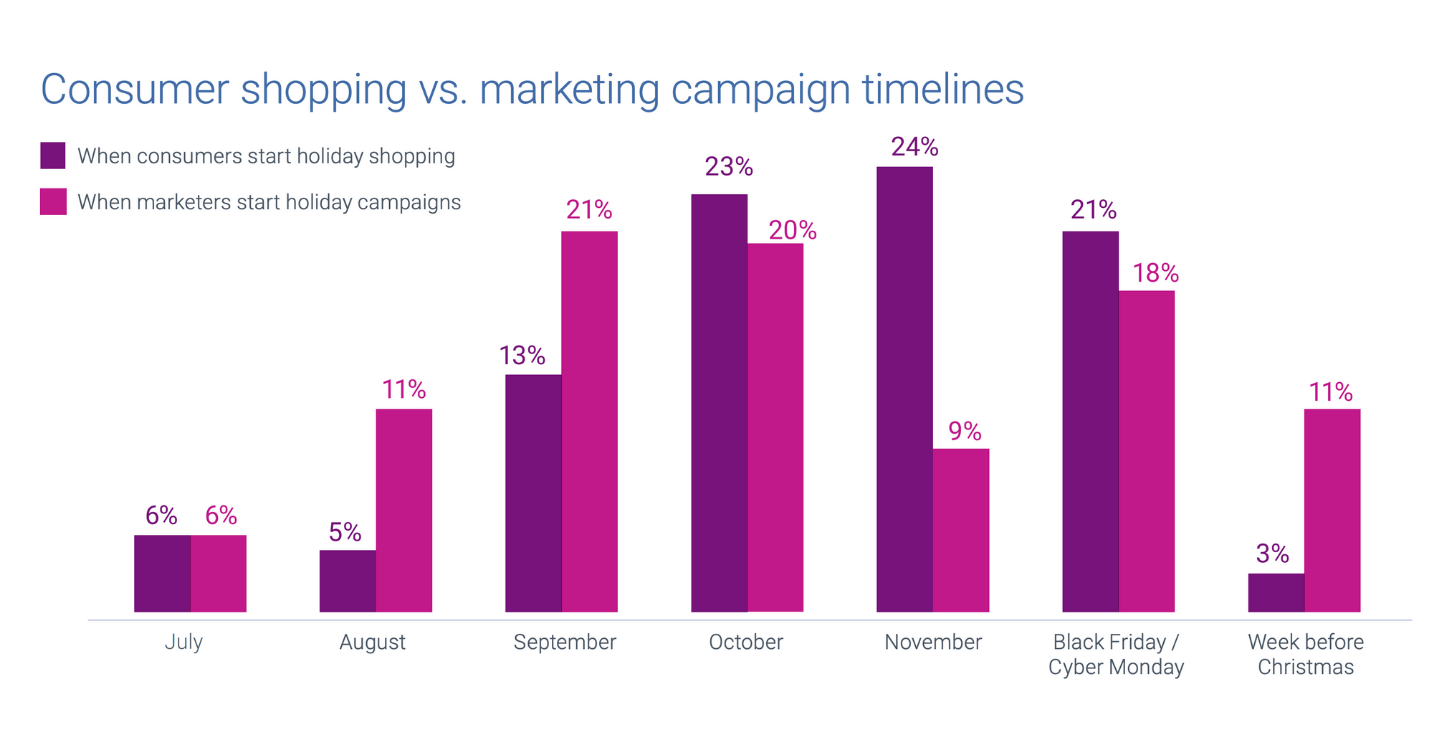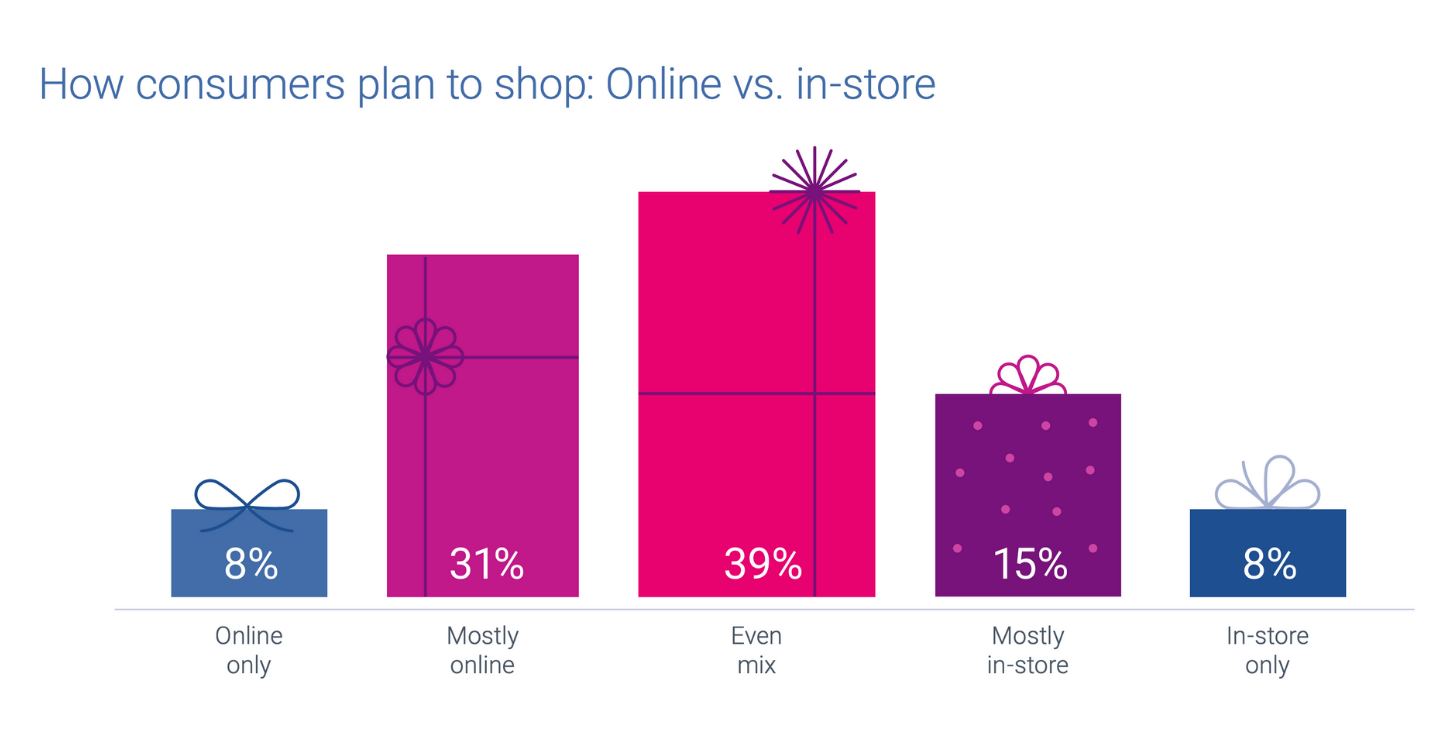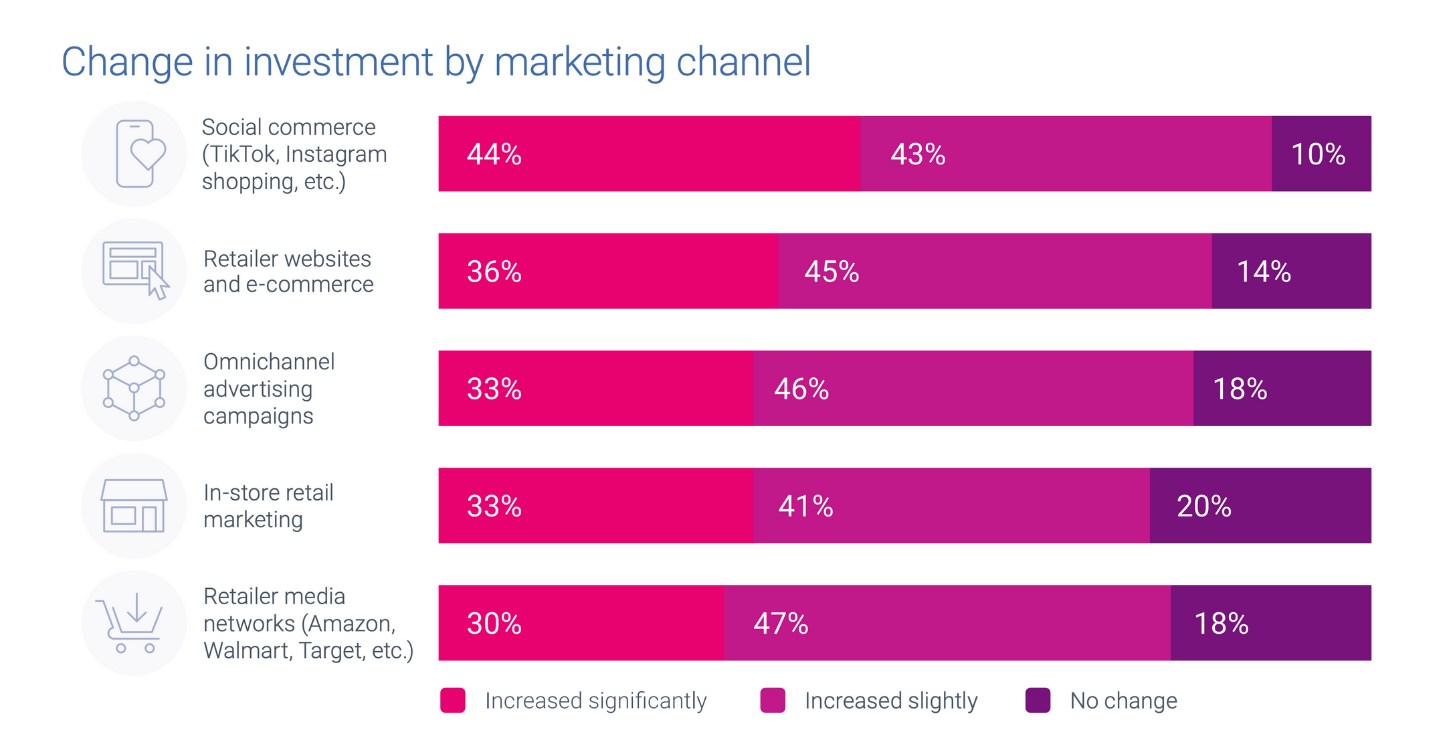At A Glance
Holiday shopping in 2025 doesn’t follow one clear pattern, with shoppers blending early planning and last-minute purchases, digital discovery and in-store validation, and cautious spending. Marketers who embrace this complexity, by staying relevant, consistent, and connected across channels, will be best positioned to win this season.Holiday shopping in 2025 feels a lot like a complicated relationship. Shoppers want deals, but they also want trust. They start shopping early, but they’re still browsing well into December. They love the convenience of online shopping, but they still show up in-store before making the final call.
Our 2025 Holiday spending trends and insights report, created this year in collaboration with GroundTruth, explores these contradictions. Our findings show that this year’s holiday season isn’t about one big shift; it’s about managing the push and pull between what consumers say, what they do, and how marketers respond.
Here are three complicated truths you need to know.
Experian’s 2025 Holiday spending trends and insights report
Optimize your 2025 holiday shopping campaigns with our latest report with GroundTruth.
Download now1. The new rules of holiday timing
Almost half (45%) of consumers plan to start shopping before November, but 62% admit they’ll still be buying in December. And post-holiday shopping (think gift card redemptions and deal-hunting) remains a real factor.


Why it’s complicated
The holiday calendar isn’t what it used to be. There’s no single “big moment” anymore. Instead, shoppers are spreading purchases across months, peaking around the “Turkey 12” (the 12 days surrounding Thanksgiving) and again in the final December rush.
What to do about it
- Stretch your campaigns across the full season, not just Cyber Week.
- Refresh offers to stay relevant as shopper motivations change from deal-seeking to last-minute urgency.
- Watch for post-holiday momentum and extend your promotions into January.
How belVita nailed the timing
In celebration of National Coffee Day, belVita partnered with GroundTruth on a one-month campaign to boost product awareness and drive foot traffic to Target stores. By utilizing digital out-of-home (DOOH) and mobile ads powered by location, behavioral, and purchase-based targeting, the campaign achieved a 3.44% visitation rate, nearly $476k in products added to carts, and a low cost-per-visit of just $0.22.
2. Online leads, but in-store still seals the deal
Nearly 40% of shoppers say they’ll split their purchases between online and in-store and 80% of consumers still prefer the in-store experience. Only a small fraction plan to shop exclusively in one channel. That means while digital often starts the journey, the final decision often happens in a physical store.

Why it’s complicated
Shoppers love the convenience of browsing online, but they still want the reassurance of seeing, touching, or testing products before buying. In-store isn’t just about the transaction, it’s the validation step.
What to do about it
- Build omnichannel strategies that connect digital discovery with in-store follow-through.
- Use location and identity data to tie digital impressions to real-world actions, like foot traffic and purchases.
- Focus on consistency: shoppers expect the same value, tone, and trust whether they’re on a website, in an app, or standing in a store aisle.
How Duke Cannon used on-premise targeting to drive sales lift
Duke Cannon, a premium men’s grooming brand, partnered with GroundTruth to launch a successful multichannel campaign utilizing location-based and behavioral audience targeting across CTV and mobile screens to drive in-store visits and sales.
By targeting consumers with mobile ads while they were physically in-store, the company capitalized on high purchase intent, aiding in the 12% sales lift. This strategic approach resulted in over 43.9k provable in-store visits and a significant increase in sales.
3. Marketers double down, consumers hold back
This holiday season, expectations are split. 66% of marketers expect holiday spend to rise, but only 22% of consumers agree. While brands are leaning into bigger investments across CTV, retail media, and social, shoppers are staying cautious, weighing value and waiting for the right deal.

Why it’s complicated
That disconnect introduces risk. If marketers don’t align spend with real consumer behavior, budgets can get wasted in the rush to cover every channel. Shoppers haven’t stopped spending, but they’re spending differently. They’re trading down to discount and big-box retailers while cutting back in discretionary categories like apparel and restaurants.
What to do about it
- Prioritize efficiency by focusing on the right audiences, not just more impressions.
- Make consistency your advantage: reach people once and connect across platforms instead of chasing fragmented signals.
- Balance aggressive media investment with messaging that acknowledges consumer caution — shoppers want value and trust, not hype.
Measuring TV and streaming impact with iSpot
iSpot’s Audience Builder, powered by Experian’s Marketing Attributes, helps brands reach high-value audiences. During the holiday season, a luxury retailer could target $100K+ households with affluent lifestyle interests. With iSpot’s Unified Measurement platform, they can track performance across linear TV and streaming and shift spend in real time to maximize results.
The bottom line on 2025 holiday shopping trends
This year’s holiday shopping season is, well…complicated. Shoppers are cautious but still engaged. They’re early planners and last-minute browsers. They want the ease of digital, but the confidence of in-person.
For marketers, the opportunity lies in embracing that complexity, not trying to simplify it away. The brands that balance relevance, trust, and convenience across the full season and across every channel will be the ones that win.
Download our full 2025 Holiday spending trends and insights report to explore all five shifts shaping this season and see how you can turn complexity into opportunity.
About the author

Fred Cheung
Director, Partnership Sales, Audigent, a part of Experian
Fred Cheung has spent over a decade in the programmatic advertising space, with roles at Mindshare, Jounce Media, Twitter, and The Trade Desk. His deep experience in trading and product management helps in his current function on the Experian Marketing Services’ Sales team where he focuses on data growth and adoption across the industries’ leading buy-side platforms.
2025 holiday shopping trends FAQs
Because consumer behavior is full of contradictions. People will shop earlier but also later, browse online but purchase in-store, and want deals while demanding trust. Marketers need to navigate these push-and-pull dynamics.
Nearly half (45%) say they’ll start before November, but 62% admit they’ll still be buying in December, with momentum even continuing into January through gift card redemptions and deal-hunting.
Although many consumers begin online, the majority still make their final decisions in-store. In-person shopping acts as a validation step where customers can see, touch, or try products before buying.
Instead of focusing only on Black Friday or Cyber Week, marketers should stretch campaigns across the full season, refresh offers frequently, and continue promotions into January.
Not entirely. 66% of marketers expect spending to rise, but only 22% of consumers agree. Shoppers are cautious, prioritizing value and often trading down to discount or big-box retailers.
An omnichannel approach using identity and location data can bridge digital impressions with real-world actions like store visits and purchases, ensuring consistency across touchpoints.
Brands like belVita and Duke Cannon successfully tied digital campaigns to in-store results by utilizing precise audience targeting, location data, and well-timed promotions.
You can download Experian’s 2025 Holiday spending trends and insights report to explore all five shifts shaping this season.
Latest posts

At the recent Beet Retreat 2023 in Santa Monica, a fireside chat featuring Kimberly Gilberti, Experian’s Chief Product Officer, shed light on how connected TV (CTV) is changing content delivery and introducing a profound shift in audience engagement and advertising strategies. In this blog post, we’ll recap Gilberti’s discussion about advertising on CTV. CTV's transformative impact on media consumption CTV brings together the nostalgia of traditional television and the cutting-edge capabilities of digital targeting, opening new doors for advertisers to connect more meaningfully with audiences. This integration heralds a new wave of viewer engagement opportunities. The revolution goes beyond altering content consumption modes; it fundamentally transforms how audiences interact with media. Advertisers now have the tools to forge deeper, more personalized connections with their audience, thanks to CTV. "The evolution of media is exciting, offering endless opportunities due to the vast inventory and engaged audiences. The key to using this is understanding the consumer, the 'who' behind the viewing."kimberly gilberti, chief product officer The evolution of advertising on CTV In CTV, traditional advertising strategies are being re-evaluated. Advertisers must pivot to meet changing viewer trends, focusing on campaigns that resonate on a personal level and harness the targeted delivery capabilities of the medium. Data and technology stand at the forefront of advertising on CTV. Effective collection, analysis, and application of audience data are crucial for creating impactful CTV campaigns. Advanced analytics tools are essential in deciphering complex viewer habits. Companies like Experian are key players, offering the necessary tools and insights for advertisers to navigate the CTV space effectively. "Experian's unique data assets are incredibly valuable. We understand consumers wherever they are, connecting the offline and online worlds. Our database, rooted in real people's information, is extensive and privacy-focused, covering virtually every U.S. household."kimberly gilberti, chief product officer The complexities and opportunities in advertising on CTV Even though the CTV landscape is filled with vast opportunities and significant challenges, one major hurdle is accurately identifying viewers within shared household accounts, complicating targeted advertising on CTV efforts. Additionally, the fragmentation of content across multiple streaming platforms amplifies the challenge of reaching specific audience segments. The presence of 'walled gardens' adds another layer of complexity in achieving a comprehensive understanding of audience behavior across different platforms. Despite these challenges, the potential for effective, personalized advertising on CTV is immense. Key to unlocking this potential is the accurate measurement of ROI and the alignment of content with viewer preferences. These areas of focus underscore the need for sophisticated identity resolution and audience analysis solutions. Collaboration is the key to unlocking CTV's potential The future of advertising on CTV relies on collaboration. Joint efforts from advertisers, agencies, technology providers, and publishers are essential for sharing data and insights while maintaining consumer privacy. This collective approach is pivotal in tackling the challenges of advertising on CTV and harnessing its full potential. As the industry dives deeper into the CTV landscape, insights from Beet Retreat 2023 and leaders like Gilberti underscore the importance of understanding and engaging with your consumers. The collaborative efforts of the industry, bolstered by technological and data-driven expertise, are critical in capitalizing on the power of CTV. Experian’s Collaboration solution connects our client's and partner's data to unlock more robust insights, smarter activation, and more holistic measurement for online and offline media efforts. To learn more about what our data collaboration services can do for your business in this new era of CTV, visit our website or connect with a member of our team today. Start collaborating with Experian Latest posts

In the fast-paced advertising world, collaboration is crucial to keep up with the flux in consumer behaviors. Samsung Ads and Experian have joined forces to address this challenge. This partnership aims to equip marketers with the necessary tools and insights to create compelling and impactful content that resonates with the right audience at the right time. By combining our expertise and precision, through this new partnership, we promise to maximize the reach, effectiveness, and efficiency of advertising campaigns. This collaboration ensures that marketing messages get noticed and strike a chord with the intended audience, leading to meaningful engagement and measurable outcomes. The Samsung Ads and Experian collaboration The powerful integration between Samsung Ads and Experian brings together Samsung Ads’ industry-leading viewership data and massive device scale with the detailed data insights of Experian. This combined effort enhances the effectiveness of advertising campaigns by merging scale with precision. Advertisers can now reap the benefits of a comprehensive solution that delivers customized content to a wide audience with unparalleled accuracy. “Navigating the dynamic landscape of digital advertising requires innovative solutions and strategic collaborations. This partnership with Samsung Ads exemplifies our commitment to empowering advertisers with data-driven insights that reach and resonate with audiences. With Experian Marketing Data directly accessible within the Samsung DSP, advertisers are equipped to orchestrate campaigns with unprecedented precision and impact, marking a significant stride in personalized advertising." chris feo, svp, sales & partnerships, experian Samsung Ads: Orchestrating reach and precision Samsung Ads’ suite of advertising solutions uses Samsung’s massive global scale to bring advertisers unmatched opportunities to engage consumers across every screen, during every moment that matters, delivering quantifiable results on a massive scale. Samsung DSP: Key features and benefits Samsung Ads believes that smarter advertising doesn’t need to be more complicated. With Samsung DSP, every intuitive feature is engineered to make media simple again, offering advertisers the ability to reach their audience more effectively, across every screen. Addressable TV Transforms traditional viewing experiences by delivering personalized content to specific households, enhancing engagement and connection. Contextual targeting Nurtures audience engagement by placing ads in relevant content environments that amplify their relevance and impact. Global reach Navigate the digital expanse with agility, delivering content to millions of consumers across devices and platforms, in brand-safe environments. Data-driven targeting Combine Samsung Ads' unrivaled proprietary device data with Experian's insights, to translate global reach into personalized consumer engagement. “The new partnership between Experian and Samsung Ads is an exciting development for advertisers as they look to maximize the effectiveness of their marketing campaigns. With hands-on access to Experian’s identity solution and audiences directly within our platform, Samsung DSP, advertisers can now better address their most important audiences on the screens they use most.”alex boras, platform lead, samsung dsp Why choose Experian in Samsung At Experian, data is more than just numbers; it tells detailed stories about what consumers like, how they behave, and their experiences. Each piece of data supports the connective networks that offer advertisers nuanced insights and actionable strategies. Ease of use Experian syndicated audiences take the guesswork out of developing segments, and they are available turnkey on the Samsung Ads shelf. Expansive reach, scale, and flexibility Our breadth and depth of data ensures detailed and targeted insights, spanning multiple verticals and can be directly attached to households, providing contextual relevance to each consumer's behaviors and purchase patterns. A rich data set that encompasses 126 million households and 750 million hashed emails 5,000 data attributes for enrichment, licensing, and audience creation 2,400 ready-to-use audiences on integrated platforms spanning 8 verticals, complemented by an average of 2,300 attributes per household and 250 attributes per consumer Four benefits to advertisers The partnership between Samsung Ads and Experian offers a plethora of benefits to advertisers, including: Enhanced audience targeting You can use Samsung Ads' ACR data and Experian's syndicated audiences to create highly targeted campaigns that reach the right audience at the right time. This can lead to significant improvements in campaign performance, such as increased engagement, conversion rates, and ROI. Optimized ad spend You can reduce wasted ad spend by using Experian's data to identify and avoid audiences less likely to be interested in your products or services. This can help you get the most out of your advertising budget. Improved attribution You can better understand the consumer journey by tracking how audiences interact with your ads across different devices and platforms. This information can be used to optimize campaigns and improve overall performance. Brand safety You can ensure that your ads are displayed in safe and secure environments by using Samsung Ads' brand safety solutions. This helps to protect brand integrity and reputation. Samsung and Experian are steering the future of advertising Together, our goal is to bring personalized and improved ad experiences to the forefront. This partnership allows advertisers to tailor their ads to individual consumer interests and needs, using the rich consumer data insights provided by Experian. Additionally, the partnership offers measurable aspects that allow advertisers to assess the effectiveness of their campaigns across various platforms, increasing their return on investment. By enhancing the overall ad experience, Samsung and Experian ensure that ads are more relevant and less intrusive, improving consumer engagement. Connect with us to learn more about how you can access our syndicated audiences in Samsung’s DSP. To learn more about our partner Samsung Ads, visit SamsungAds.com. Latest posts

Industry leaders recently gathered at the influential Beet Retreat 2023 conference held in Santa Monica, sharing forward-looking perspectives on the future of advertising. This renowned event known for its diverse mix of leaders from TV, agencies, advertising, and technology sectors, was enriched by insights from Experian’s very own Chris Feo, SVP of Sales & Partnerships, and Kimberly Gilberti, Chief Product Officer. Both Feo and Gilberti brought their expertise and perspectives for harnessing the potential of high-growth connected TV (CTV) advertising. The era of connected everything at Beet Retreat 2023 In the “Era of Connected Everything,” panel, Feo dived into the concept of a ‘connected everything’ world. He emphasized the importance of balancing consumer and privacy expectations with the increasing integration of AI and machine learning. “As decisioning evolves, creative tech and data derived from creative scale will play a bigger role.”chris feo, svp, sales & partnerships Feo further discussed the potential of creative technology, particularly in how AI and machine learning could revolutionize content personalization. He cited examples where the same creative content is used indiscriminately across diverse demographics, suggesting a future where creative content adapts and performs well for a variety of audience identities. Experian's balanced approach at Beet Retreat 2023 During a fireside chat, Gilberti shared her vision on the transformative role of television in the advertising technology landscape. “Connecting exposure to business outcomes is the holy grail of measuring CTV and effectiveness.”kimberly gilberti, chief product officer Her insights reflected the growing interplay between digital and traditional TV advertising, and the opportunities arising from this convergence. Gilberti emphasized the critical role of data analytics in enabling advertisers to tailor content more effectively to diverse TV audiences. She envisioned a future where the integration of digital strategies and traditional TV advertising create a more cohesive and impactful AdTech approach. Future focus: Diversification and partnerships Both Feo and Gilberti underscored the need for advertisers to diversify their partnerships. By working with a variety of partners, you can mitigate risks and foster innovation, ensuring you are not overly dependent on a single channel or approach. Navigate what’s next with Experian Experian's contributions at Beat Retreat 2023 underscore our pivotal role in the AdTech industry. With a unique balance of offline and online data expertise, we are not just adapting to changes but leading the way in innovation and strategy. Our insights and approaches, as highlighted by Feo and Gilberti, demonstrate our commitment to guiding the industry through its rapid evolution, making our role indispensable in the future of advertising technology. At Experian, we’re your partner in data-driven marketing and can help make your interactions more meaningful. To learn more, connect with a member of our team today. Connect with us Latest posts